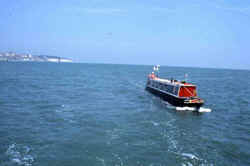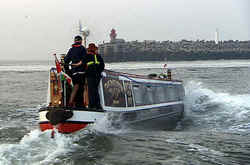The name Tarbert is the anglicised form of the Gaelic word tairbeart. It is composed of tar "across" and a form of the verb beir "carry" and literally translates as "across-carrying". This refers to the narrowest strip of land between two bodies of water over which goods or entire boats can be carried (portage). In past times cargoes were discharged from vessels berthed in one loch, hauled over the isthmus to the other loch, loaded onto vessels berthed there and shipped onward, allowing seafarers to avoid the sail around the Mull of Kintyre.
https://en.wikipedia.org/wiki/Tarbert,_Argyll_and_Bute
But ships were also carried across and 'tar' is a shortened version of 'tarraing' which means to pull. The 'bert' bit is 'beart' which normally means a machine or a weaving frame. Something with ropes of some sort. So if we put the two elements together we could have a set up with ropes for hauling ships from one side to the other. This is something the Vikings did to perfection even getting into Loch Lomond.
Dwelly has:
tairbeart /tɛrʲɛbəRʃd/
boir. gin. -beirt, iol. -an
isthmus, portage site
http://faclair.com/
Beart also refers to wealth.
There's a video on youtube where some Norwegians build a replica longboat and sail to Orkney. They then test out the idea that the ships were carried across the land to the water on the other side. They have great difficulty especially with the friction of the boat on the ground or whatever they are supporting it on. Until a local Orcadian tells them that the old fisherman used fish oil to lubricate it. So they do this and I think they succeeded.


